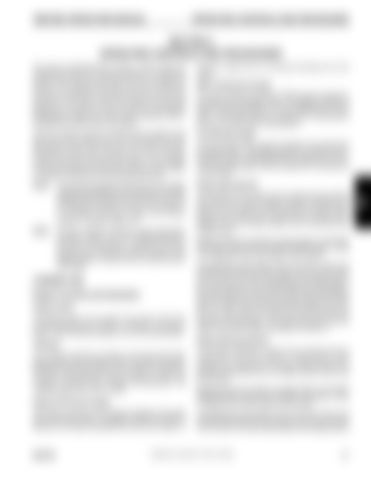TMS700E OPERATORS MANUAL
OPERATING CONTROLS AND PROCEDURES
SECTION 3 OPERATING CONTROLS AND PROCEDURES The crane is equipped with two cabs, a carrier cab and a superstructure cab. The carrier cab (Figure 3-1) contains all controls and indicators necessary for crane traveling and parking. The superstructure cab (Figure 3-3) contains all controls and indicators necessary to perform all craning operations. Both cabs utilize international symbols and English text to label the various controls. For detailed information on either cab, refer to either CARRIER CAB or SUPERSTRUCTURE CAB in this Section.
receives a signal from an oil pressure sending unit on the engine.
Water Temperature Gauge The engine coolant temperature (TEMP) gauge is located on the lower left of the gauge cluster. The gauge indicates the engine coolant temperature on a scale calibrated from 100 to 240F. The gauge receives a signal from a temperature sending unit in the engine cooling system.
The front console is laid out vertically and is located in the right front of the superstructure cab. This location provides the operator with a clear view out of the front of the cab. Additional indicators and switches are on the overhead console above the right side cab window. The outrigger controls are located on a hand held control box that is stored in a pocket on the left front of the superstructure cab.
Fuel Quantity Gauge
NOTE:
Engine Stop Indicator
NOTE:
The following paragraphs describe all the available (standard and optional; some machines may not be equipped with the optional controls shown) controls and indicators located in the cab. The numbers in ( ) represent the index number from Figure (Figure 3-1) through (Figure 3-3). All rocker switches, except the engine diagnostics switches, contain one or two LED lighted slots in the switch for illumination. In addition, all but the hydraulic pump disconnect switch contains a LED lighted square to indicate when the switch/function is activated.
CARRIER CAB Engine Controls and Indicators Gauge Cluster The gauge cluster (5) is located in the center of the front console assembly and contains a voltmeter, oil pressure gauge, water temperature gauge, and a fuel quantity gauge.
The fuel quantity (FUEL) gauge is located on the upper left of the gauge cluster. The gauge indicates the quantity of fuel in the tank and has a scale calibrated from empty (E) to full (F). The fuel quantity gauge receives a signal from a sending unit in the fuel tank.
The ENGINE STOP indicator (23) is located at the top middle left of the front console. It lights red when energized by a signal from the engine ECM that signifies a serious engine problem that requires the vehicle and the engine to be stopped as soon as safely possible. Also a warning buzzer will also sound. Besides alerting the operator of system faults, the ENGINE STOP light, along with the ENGINE WARNING light, is used in the diagnostic work of the engine control system. The diagnostic mode begins when the ignition switch and ENGINE DIAGNOSTICS TEST switch are on and the engine is not running. The amber light flashes at the beginning of a fault code sequence, the red light flashes the three-digit or four-digit code for the active fault and the amber light flashes again to separate the previous red light sequence from the next one. Each code will be flashed twice before moving to the next code. When all codes have been flashed, the sequence will begin again. If no codes are present, both the engine warning and engine stop lights will remain on.
Engine Warning Indicator
Voltmeter The voltmeter (VOLTS) is located on the lower right of the gauge cluster. With the ignition switch in the RUN (1) position and before starting the engine, the voltmeter indicates the condition of the batteries. With the engine running, the voltmeter indicates output voltage of the alternator. The voltmeter scale is from 10 to 16 volts.
The ENGINE WARNING indicator (24) is located at the top middle left of the front console. It lights amber when energized by a signal from the engine ECM that gives the operator a signal that there is an engine problem which must be corrected.
Engine Oil Pressure Gauge
Besides alerting the operator of system faults, the ENGINE WARNING light, along with the ENGINE STOP light, is used in diagnostic work of the engine control system.
The engine oil pressure (OIL) gauge is located on the upper right of the gauge cluster. The gauge indicates the engine oil pressure on a scale calibrated from zero (0) to 80 psi. It
The diagnostic mode begins when the ignition switch and ENGINE DIAGNOSTICS TEST switch are on and the engine is not running. The amber light flashes at the beginning of a
GROVE
Published 10-05-2010, CTRL # 102-06
3-1
3


